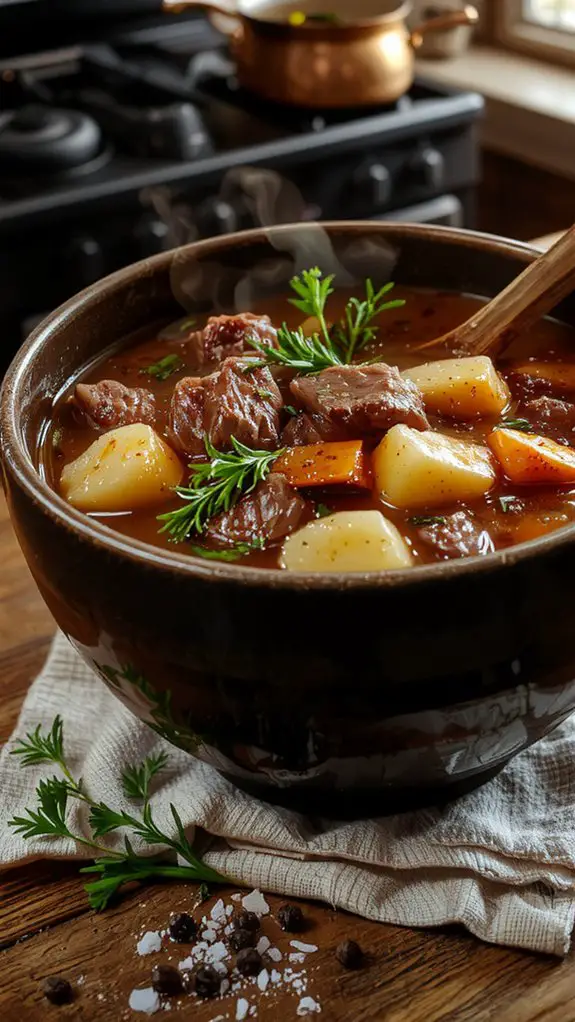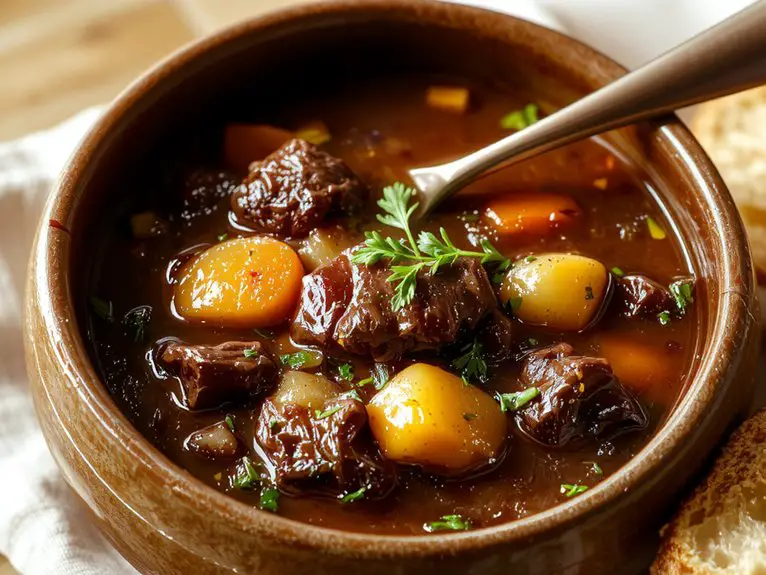I’ve been perfecting my beef stew recipe for years, and I’ve found it’s all about balancing flavors and patience. The key lies in searing the beef for depth, simmering it slowly for tenderness, and layering aromatics and herbs for richness. There’s something comforting about a pot of stew simmering on the stove, filling the kitchen with warmth. If you’re looking to elevate your comfort food game, this recipe might just surprise you.
Recipe
There’s nothing quite like a steaming bowl of homemade beef stew to warm you up from the inside out—and this recipe? It’s the kind of dish that’ll have everyone at the table begging for seconds. Tender chunks of beef simmered low and slow with hearty vegetables in a rich, savory broth—this is comfort food at its absolute best.
What sets it apart? A splash of red wine for depth, fresh herbs for brightness, and just the right amount of time to let the flavors meld into something magical.
Imagine this: melt-in-your-mouth beef, carrots that still have a little bite, and potatoes so soft they practically dissolve on your tongue. Whether it’s a chilly weeknight or a lazy Sunday, this stew is your ticket to cozy perfection—and trust me, once you try it, you’ll never go back to store-bought again.
Ingredients
For the ultimate beef stew, you’ll want hearty, flavorful ingredients that build layers of taste as they simmer. Choose high-quality beef and fresh vegetables for the best results, but don’t stress—there’s room for flexibility if you’re missing something.
– Stew meat (chuck roast or beef brisket): These cuts are rich and tender when slow-cooked. Trim excess fat, but leave some for flavor.
*Pro Tip: Cut the meat into uniform 1.5-inch pieces for even cooking.*
– Onions, carrots, and celery (the “holy trinity”): Essential for building the stew’s base. Dice them evenly.
*Substitution: Leeks can replace onions for a sweeter flavor.*
- Garlic: Adds depth—mince it finely or use a garlic press for maximum flavor infusion.
- Potatoes (Yukon Gold or russet): These hold their shape well during cooking. Peel or leave the skin on for added texture.
*Substitution: Sweet potatoes for a twist!*
- Beef broth: Use low-sodium to control the saltiness. Homemade broth is a game-changer if you have it.
- Tomato paste: A concentrated burst of umami that thickens the stew slightly.
*Pro Tip: Brown it in the pan before adding liquids for a richer taste.*
– Flour: To coat the beef and thicken the stew.
*Substitution: Cornstarch slurry (1:1 with water) for a gluten-free option.*
– Red wine (optional): Adds complexity. A dry red like Cabernet Sauvignon works best.
*Substitution: Beef broth with a splash of balsamic vinegar.*
– Bay leaves, thyme, and rosemary****: Herbs that elevate the flavor profile. Fresh is ideal, but dried works too.
*Pro Tip: Tie herbs together with kitchen twine for easy removal.*
– Olive oil or butter: For browning the meat and vegetables.
*Pro Tip: Use both for a richer flavor.*
- Salt and pepper: Season generously throughout the cooking process.
- Optional extras: Mushrooms, peas, or pearl onions for added texture and flavor.
*Little Win: Top with fresh parsley for a pop of color and freshness before serving.*
How to Make the Best Classic Beef Stew Instructions

- Simmer the stew: Return the beef to the pot and add bay leaves, thyme, and a pinch of salt and pepper. Bring to a boil, then reduce the heat to low. Cover and simmer for 1.5 to 2 hours, stirring occasionally. Low and slow cooking guarantees tender meat.
- Add potatoes: About 30 minutes before the stew is done, add peeled and cubed potatoes. This prevents them from becoming too mushy while still cooking through.
- Check for seasoning: Taste the stew and adjust salt, pepper, or herbs as needed.
Pro tip: If the stew tastes bland, a splash of Worcestershire sauce or soy sauce can boost the umami flavor.
- Finish with parsley: Stir in fresh chopped parsley just before serving for a bright, fresh note. Avoid adding it too early, as it can lose its vibrant color and flavor.
- Serve and enjoy: Ladle the stew into bowls and serve with crusty bread or over mashed potatoes. Leftovers taste even better the next day as the flavors continue to meld.
Nutrition
This hearty beef stew is packed with nutrients from fresh vegetables and lean beef. Here’s the nutritional breakdown per serving:
| Nutrient | Amount per Serving |
|---|---|
| Calories | 320 kcal |
| Protein | 28g |
| Fat | 12g |
| Carbohydrates | 25g |
| Fiber | 4g |
| Sodium | 480mg |
Chef Tips
Mastering the art of beef stew requires a blend of patience and technique. I always sear the meat in batches to avoid steaming—it locks in flavor.
Use a mix of stock and wine for depth, and don’t skimp on seasoning layers.
Let it simmer low and slow; tender stews can’t be rushed.
Finish with fresh herbs for brightness, and always taste before serving.






